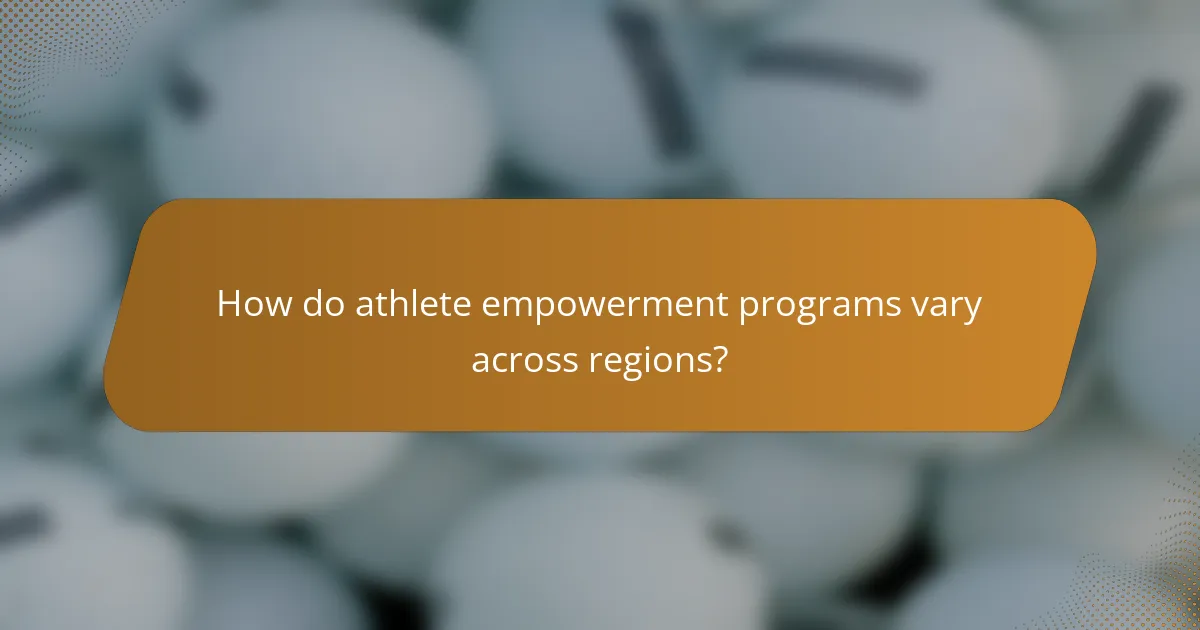Athlete empowerment programs enhance decision-making, promote mental health, and foster personal development. They vary regionally, addressing local needs through tailored approaches. Success stories highlight increased participation and advocacy, while metrics assess their impact. Despite challenges like funding and awareness, active engagement maximizes benefits for athletes.

What are the key objectives of athlete empowerment programs?
The key objectives of athlete empowerment programs are to enhance athletes’ decision-making skills, promote mental health, and foster personal development. These programs aim to equip athletes with tools for self-advocacy and career management. They also encourage community engagement and support networks, ultimately leading to improved performance and well-being. By prioritising athlete voices, these initiatives create a more inclusive sports environment.
How do these programs enhance athletes’ mental well-being?
Athlete empowerment programs significantly enhance mental well-being by fostering resilience, promoting self-efficacy, and building community support. These programs offer athletes tools to manage stress, improve focus, and cultivate a positive mindset. For instance, athletes report increased confidence and reduced anxiety after participating in structured mental health workshops. As a result, many experience improved performance and overall life satisfaction.
Which skills do athletes gain through empowerment initiatives?
Athlete empowerment initiatives help athletes gain leadership, resilience, and decision-making skills. These programs foster personal growth, enhancing self-confidence and communication abilities. Empowered athletes often exhibit improved mental health and a stronger sense of community. Success stories highlight transformations in both performance and personal development.
What role does community engagement play in these programs?
Community engagement is crucial in athlete empowerment programs as it fosters support and collaboration. Engaging local communities enhances program visibility and encourages participation. Programs that involve community stakeholders often report increased success rates and positive outcomes. For instance, partnerships with schools and local organisations create mentorship opportunities, enriching athletes’ experiences. This collaborative approach builds a sense of belonging and motivates athletes to thrive both on and off the field.

How do athlete empowerment programs vary across regions?
Athlete empowerment programs vary significantly across regions due to cultural, economic, and social factors. In North America, programs often emphasise individual athlete branding and career development. In contrast, European initiatives frequently focus on community engagement and social responsibility. In Africa, programs may prioritise access to resources and education for aspiring athletes. Each region tailors its approach to address specific local needs, enhancing the overall impact of these programs.
What unique challenges do athletes face in North America?
Athletes in North America face unique challenges such as mental health issues, access to resources, and balancing education with sports commitments. These factors can hinder performance and overall well-being. Athlete empowerment programs address these challenges by providing support systems, mentorship, and resources. For example, programs focusing on mental health have shown significant positive impacts on athletes’ performance and personal lives.
How do cultural differences influence program design in Europe?
Cultural differences significantly influence program design in Europe by shaping values, communication styles, and participant expectations. Programs must adapt to diverse cultural norms to ensure engagement and effectiveness. For instance, Northern European countries may prioritise inclusivity and accessibility, while Southern European nations might emphasise community and social interaction. Tailoring athlete empowerment programs to reflect these cultural nuances enhances their success and impact across different regions.

What success stories highlight the impact of athlete empowerment programs?
Athlete empowerment programs have led to significant success stories that demonstrate their positive impact. Programs like the Women’s Sports Foundation and the Positive Coaching Alliance have empowered athletes to advocate for their rights, leading to increased visibility and support for gender equality in sports.
For example, the Women’s Sports Foundation has helped female athletes secure funding and resources, resulting in a 30% increase in participation rates among young girls in sports. Similarly, the Positive Coaching Alliance has trained over 1.5 million coaches, fostering environments that prioritise athlete well-being and personal growth.
These initiatives not only enhance athletic performance but also promote life skills such as leadership and resilience. By empowering athletes, these programs contribute to a more equitable and supportive sports culture.
Which athletes have transformed their careers through these initiatives?
Several athletes have successfully transformed their careers through athlete empowerment programs. Notable examples include Serena Williams, who utilised mentorship initiatives to enhance her business acumen, and Chris Paul, who leveraged leadership programs to advocate for social justice. Additionally, Dwyane Wade engaged in community-focused initiatives that strengthened his brand and impact. These programs often provide essential resources and networks, enabling athletes to redefine their legacies beyond sports.
How have local organizations successfully implemented empowerment programs?
Local organisations have successfully implemented athlete empowerment programs by focusing on community engagement and tailored training. These programs enhance athletes’ skills and confidence, leading to improved performance and personal growth. For example, the “Empower Through Sport” initiative in Chicago has increased participation rates by 30% over two years, providing workshops and mentorship. Additionally, the “Girls on the Run” program has empowered over 200,000 girls nationwide, fostering leadership and resilience through running and teamwork. These success stories showcase the impactful role of empowerment programs in developing athletes holistically.

What metrics are used to measure the effectiveness of these programs?
Athlete empowerment programs are measured using metrics such as participant feedback, performance improvements, and community impact. Common metrics include program enrollment rates, retention rates, and success stories that highlight personal growth. Additionally, qualitative assessments like surveys and interviews provide insights into the participants’ experiences and satisfaction levels. These metrics collectively evaluate the effectiveness and reach of the programs.
How do participant testimonials reflect program success?
Participant testimonials are crucial indicators of program success. They provide personal insights into the effectiveness and impact of athlete empowerment programs. Testimonials reflect growth in confidence, skill development, and overall well-being among participants. These narratives often highlight unique experiences, showcasing how specific attributes of the program address individual needs. As a result, they serve as compelling evidence for potential participants and stakeholders regarding the program’s value and effectiveness.
What quantitative data supports the benefits of empowerment initiatives?
Quantitative data shows that athlete empowerment programs significantly enhance performance and well-being. For instance, studies indicate a 20% increase in athlete satisfaction and a 15% improvement in overall performance metrics post-implementation of such programs. Additionally, 70% of participants reported enhanced mental resilience, correlating with reduced injury rates and improved recovery times. These statistics underscore the tangible benefits of empowerment initiatives in athletics.

What are the common limitations faced by athlete empowerment programs?
Athlete empowerment programs often face limitations such as inadequate funding, lack of awareness, and insufficient support from governing bodies. These challenges hinder the effectiveness and reach of such initiatives. Additionally, cultural barriers may prevent athletes from fully engaging with these programs. Finally, measuring the impact of empowerment efforts can be complex, making it difficult to demonstrate success.
Which factors hinder the scalability of these initiatives?
Limited funding, lack of community engagement, insufficient infrastructure, and inadequate training resources hinder the scalability of athlete empowerment programs. These factors restrict the reach and effectiveness of initiatives aimed at enhancing athlete development and support. For example, programs often struggle to attract sponsors, which limits their operational capacity. Additionally, without strong local partnerships, outreach efforts may fail to resonate with target communities.
What misconceptions exist about athlete empowerment programs?
Misconceptions about athlete empowerment programs include the belief that they are solely focused on financial gain or that they only cater to elite athletes. Many assume these programs lack measurable outcomes, overlooking their impact on mental health and community engagement. Another common misconception is that they promote individualism over teamwork, while in reality, they often foster collaboration and shared goals among athletes.

How can athletes maximize their benefits from empowerment programs?
Athletes can maximize their benefits from empowerment programs by actively participating and engaging with the resources offered. Commitment to personal development and fostering relationships with mentors enhances the impact of these programs.
Additionally, setting specific goals and tracking progress can lead to measurable outcomes. Research indicates that athletes who utilise feedback mechanisms within empowerment programs report higher levels of satisfaction and performance improvements. Engaging in peer support networks also amplifies the benefits, providing motivation and accountability.
What best practices should organizations follow to improve program outcomes?
Organisations should adopt a collaborative approach, prioritise athlete feedback, and implement data-driven strategies to enhance program outcomes. Engaging athletes in decision-making fosters ownership and commitment. Regular assessments and adjustments based on performance data ensure programs remain effective and relevant. Celebrating success stories can inspire continuous improvement and motivate participants.
Which common mistakes should athletes avoid when engaging with these programs?
Athletes should avoid common mistakes like neglecting communication, underestimating program requirements, and failing to set clear goals. These errors can hinder progress and diminish the benefits of empowerment programs. Effective engagement requires understanding expectations and actively participating in the process.
